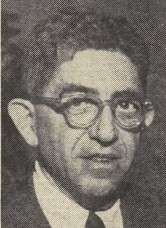Ernest Nagel
Ernest Nagel (November 16, 1901 – September 20, 1985) was an American philosopher of science.[1][2] Along with Rudolf Carnap, Hans Reichenbach, and Carl Hempel, he is sometimes seen as one of the major figures of the logical positivist movement.
Ernest Nagel | |
|---|---|
 Ernest Nagel (c. 1955) | |
| Born | November 16, 1901 |
| Died | September 20, 1985 (aged 83) |
| Education | CCNY (BSc, 1923) Columbia University (PhD, 1931) |
| Era | 20th-century philosophy |
| Region | Western philosophy |
| School | Analytic |
| Institutions | Columbia University |
Main interests | Philosophy of science |
Influences
| |
Influenced
| |
Life and career
Nagel was born in Nové Mesto nad Váhom (now in Slovakia, then Vágújhely and part of the Austro-Hungarian Empire). His mother, Frida Weiss, was from the nearby town of Vrbové (or Verbo). He emigrated to the United States at the age of 10 with his family, and became a U.S. citizen in 1919. He received a BSc from the City College of New York in 1923, and earned his PhD from Columbia University in 1931, with a dissertation on the concept of measurement. Except for one year (1966-1967) at Rockefeller University, he spent his entire academic career at Columbia. He became the first John Dewey Professor of Philosophy there in 1955.[3] And then University Professor from 1967 until his retirement in 1970, after which he continued to teach. He was elected to the National Academy of Sciences in 1977.
His work concerned the philosophy of mathematical fields such as geometry and probability, quantum mechanics, and the status of reductive and inductive theories of science. His book The Structure of Science (1961) practically inaugurated the field of analytic philosophy of science. He expounded the different kinds of explanation in different fields, and was sceptical about attempts to unify the nature of scientific laws or explanations. He was the first to propose that by positing analytic equivalencies (or "bridge laws") between the terms of different sciences, one could eliminate all ontological commitments except those required by the most basic science. He also upheld the view that social sciences are scientific, and should adopt the same standards as natural sciences.
Nagel wrote An Introduction to Logic and the Scientific Method with Morris Raphael Cohen, his CCNY teacher in 1934. In 1958, he published with James R. Newman Gödel's proof, a short book explicating Gödel's incompleteness theorems to those not well trained in mathematical logic. He edited the Journal of Philosophy (1939–1956) and the Journal of Symbolic Logic (1940-1946).
He died in New York. He had two sons, Alexander Nagel (professor of mathematics at the University of Wisconsin) and Sidney Nagel (professor of physics at the University of Chicago).
At a meeting of the executive council of the Committee for Skeptical Inquiry (CSI) in Denver, Colorado in April 2011, Nagel was selected for inclusion in CSI's Pantheon of Skeptics. The Pantheon of Skeptics was created by CSI to remember the legacy of deceased fellows of CSI and their contributions to the cause of scientific skepticism.[4]
Nagel's doctoral students include Morton White, Patrick Suppes, Henry Kyburg, Isaac Levi, and Sidney Morgenbesser.
Books
- On The Logic of Measurement (1930)
- An Introduction to Logic and Scientific Method (with M. R. Cohen, 1934)
- The Formation of Modern Conceptions of Formal Logic in the Development of Geometry (1939)
- Principles of the Theory of Probability (1939)
- The Meaning of Reduction in the Natural Sciences (1949)
- Sovereign Reason (1954)
- Logic without Metaphysics (1957)
- Gödel’s Proof (with J. R. Newman, 1958)[5]
- The Structure of Science: Problems in the Logic of Scientific Explanation (1961, second ed. 1979)
- Observation and Theory in Science (with others, 1971)
- Teleology Revisited and Other Essays in the Philosophy and History of Science (1979)
References
- Suppes, Patrick (February 2000). "Nagel, Ernest". American National Biography Online. Retrieved 10 April 2014.
- Suppes, Patrick (1994). "Ernest Nagel" (PDF). Biographical memoirs of the National Academy of Sciences. National Academy of Sciences. Retrieved 10 April 2014.
- "Columbia Daily Spectator 9 December 1955 — Columbia Spectator". spectatorarchive.library.columbia.edu. Retrieved 2019-09-27.
- "The Pantheon of Skeptics". CSI. Committee for Skeptical Inquiry. Archived from the original on 31 January 2017. Retrieved 30 April 2017.
- Nagel, Ernest (1958). Gödel's Proof. New York: New York University Press.